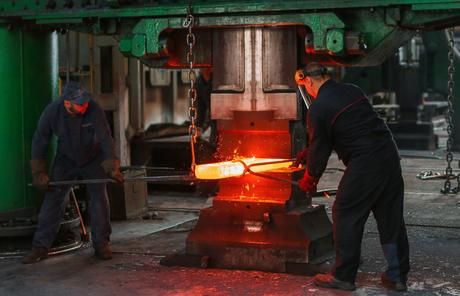 Manufacturing is a huge industry, and as time goes by, it is projected to grow. As the sophistication of everyday human needs grows and commodities slowly become necessities – it's only a matter of time before manufacturing will evolve to fit our new requirements.
Manufacturing is a huge industry, and as time goes by, it is projected to grow. As the sophistication of everyday human needs grows and commodities slowly become necessities – it's only a matter of time before manufacturing will evolve to fit our new requirements.Manufacturers can satisfy most of our product needs, both corporate, infrastructural, and personal. However, we live in a day and age where technology advances at a never-before-seen pace, meaning manufacturing will have to catch up.
In this article, we'll talk a bit about manufacturing in its current state, how it might change in the coming years, and what changes we can expect due to rapid technological advancement.
Exploring the Current State of the Manufacturing Industry
The current state of the manufacturing industry is fantastic. Not only are the rapid technological advancements changing the way that machinery works, but technology is also actively removing flaws from everyday products and significantly speeding up things in factories.With the advancement of AI technology, large factories in the automotive industry are already implementing AI-driven automation solutions to make material production much quicker and offer higher quality results.
While some industries are quicker to adopt new-age solutions such as AI, it's fair to say that others are falling behind. For example, manufacturing rubber and concrete is done much like it was decades ago, at least in most places. The world's biggest concrete producer in China and China factories are less than modern in most ways.
Advanced or Archaic | the State of Production and Manufacturing Around the World
While it will take a long time to revolutionize and update such a large industry, it still begs the question: How much can manufacturing and production improve?The answer to that question depends on the industry, factory, and country in question. First-world countries are usually the quickest to adapt to new technologies, as they sell off their used plastic machinery and other manufacturing machinery to different countries or smaller factories.
The countries that aren't as wealthy purchase second-hand machinery, which can also be a great deal. High-end companies usually change their machines as soon as something better hits the market. That allows other companies to scoop up fantastic, fully operational, and well-maintained second-hand machines for cheap.
Common Issues Present in Manufacturing
Sadly, not all companies and factories can afford to purchase even second-hand machinery, which leads us to another problem – archaic machinery for manufacturing and production on the modern road. That isn't the only thing that makes the modern world of manufacturing fall behind. More than a few problems are faced by both factories doing the manufacturing and the workers that make it all possible.Lax Safety
There is a reason why machinery tends to change every once so often, and that reason isn’t solely streamlining production and making money. Safety standards improve massively with each new generation, and so do many different things that make the workplace a better place.Workplace safety has come a long way, and it continues to do so. For example, workers in factories must be trained on workplace safety extensively before they ever step foot on the factory floor, and awareness is at an all-time high. But, humans aren't the only ones that create dangerous scenarios, as archaic machinery and faulty practices still kill hundreds every year.
Environmental Impact
The green movement has steadily been gaining traction since the early two-thousands, and just like safety awareness, it is at an all-time high. Going more green usually costs companies a lot of money both in the short term and in the long term.There is no universal green solution for manufacturing as of writing this article, and there isn't going to be one available and attainable any time soon. It’s a major issue, as we're polluting the world at a rapidly advancing pace. Factories account for most greenhouse gasses, ozone pollution, water pollution, and a range of other hazardous things.
Keeping Up With The Times
As technology advances, so do the options on factory floors. Now, unless you’re running a multi-billion dollar factory, the chances of replacing your equipment the moment that something better reaches the market are pretty low.It’s a major issue for many factories, as keeping up with the times is insanely expensive and usually doesn't return a profit. Moreover, many would argue that the rapid advance in technology that enables better business practices is unattainable, and that's because as solutions get more sophisticated, they get more expensive.
Many factories are falling behind their mega corporation competition as they simply can't keep up with the new equipment and machinery entering the market every month.
Skills Gap
As time goes by, the number of qualified professionals prepared to work in a specialized manufacturing environment is dropping rapidly. That’s because younger people aren't interested in working in large factories, and the number of people getting into manufacturing is steadily declining.It doesn’t help that the economies around the world are suffering and that there are arguably more comfortable jobs that offer better working conditions and pay than manufacturing.
Furthermore, manufacturing requires highly qualified and specialized individuals in some fields, and the number of people who are capable of doing some tasks is in free fall. All of this combined creates a massive skills gap that is cause for concern.
So, What Does the Future Hold for Manufacturing?
We have a relatively simple question with a fairly simple answer – as with most things in the near future, we are firm believers that it will be "smart." We've seen the smart device revolution happen before our very eyes with the very first smartphone, the first smart TV, and even smart fridges.However, before smart technology reached the hands of the consumer base, it was already widespread across the world of manufacturing. High-end manufacturing equipment is already "smart," as it is automated to an extent through advanced software and algorithms, and even things such as artificial intelligence.
It has proven itself to be a critical asset to the modern manufacturing and production industry. Smart tech has single-handedly improved work output and workplace safety and revolutionized how modern factories operate.
Which Technologies Will Influence Manufacturing the Most?
While on the topic of technologies, you’d be surprised just how many of them are finding their way into factory floors at the moment. But, while all of these new technologies are relatively primitive and young, if the trend continues on its upwards trajectory of mass adoption, the factories of tomorrow are going to be far, far different than they are today.The main development that we see more and more in modern factories is AI and the implementation of AI into modern machinery. AI makes it – so many of the tasks that go on factory floors are as automated as possible. Furthermore, AI has a massive role in control modules, which allow equipment to operate on an individual basis.
Things such as CNC machines couldn't run without some form of an algorithm, and they're slowly adopting AI into their midst. Furthermore, AI has a massive role in designing new products, streamlining shop floors and factory operations, and logistics.
Other than AI, we have Big Data at our doorstep –it’s mostly a concept rather than a technology, but it does exist in some regard. Big Data will allow companies to store massive quantities of operational data, access them with ease through SQL engines, and optimize their operations through smart analysis. Lastly, IoT is another exciting technology that shows promise to change how factory floors work. IoT can minimize downtime by providing smart, factory-floor-based visibility over all the machinery and controlling what goes on and when.
To put this into perspective. IoT can centralize all of the machines and equipment running in factories, meaning that controlling it becomes as easy as using one centralized interface, rather than worrying about every machine individually.
In Conclusion
The world of manufacturing is going to have to change to accommodate our new needs. As humanity evolves, our needs become ever more elaborate, requiring a robust and capable manufacturing industry to support them.Things that used to be a novelty are now necessities, and as time goes by, more and more things become necessities. If factories and manufacturing keep up with our rising demands, things will have to go the digital route.
Work output will need to be better, faster, and more refined – and as things are looking at the moment, artificial intelligence and cloud solutions are likely to bring this revolution to the factory floors.

